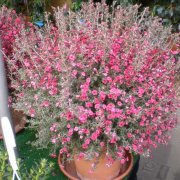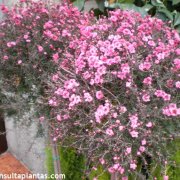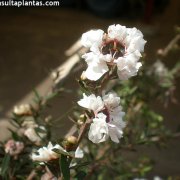Care of the shrub Leptospermum scoparium or Manuka myrtle |
|
The genus Leptospermum, family Myrtaceae, comprises 80 species of shrubs and trees native to Oceania and Indonesia. Some species are: Leptospermum scoparium, Leptospermum petersonii, Leptospermum grandiflorum, Leptospermum myrtifolium, Leptospermum rotundifolium. Common names: Manuka myrtle, New Zealand teatree, Tea tree. This species is native to New Zealand and Australia. They are evergreen shrubs with a rounded shape that can reach 2 meters (6.56 feet) in height. The abundant and showy flowers are red, pink, white, orange or purple. They bloom in spring. Manuka myrtle is used as isolated specimens, in bushy groups, as indoor plants and in large pots in regions with a Mediterranean climate; it's used in greenhouses without heating if the climate is colder. Leptospermum scoparium needs a sunny or light shade exposure; indoors it needs a very bright location. In spring and summer take it outside. The soil can be a mixture, in equal parts, of sand mulch, coarse siliceous sand and garden substrate. It's very important that the soil drains well. Water abundantly, waiting for the substrate to dry during spring and summer; reduce watering the rest of the year. Fertilize once a month with mineral fertilizer in spring and summer. New Zealand teatree is a quite resistant plant to the usual pests and diseases. Leptospermum scoparium propagates from herbaceous cuttings but it's more advisable to buy new plants in nurseries and garden centers. |
Images of the shrub Leptospermum scoparium or Manuka myrtle |
Find plants
Leptospermum scoparium or Manuka myrtle | Care and Growing
© 2025 FavThemes





